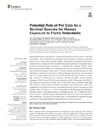Please use this identifier to cite or link to this item:
https://accedacris.ulpgc.es/handle/10553/22908
| Título: | Potential role of pet cats as a sentinel species for human exposure to flame retardants | Autores/as: | Henríquez Hernández, Luis Alberto Carretón, Elena Camacho Rodríguez, María Montoya-Alonso, JA Boada, luis d Bernal Martín, Verónica Falcón Cordón, Yaiza Falcón Cordón, Soraya Zumbado, Manuel Pérez Luzardo, Octavio Luis |
Clasificación UNESCO: | 3109 Ciencias veterinarias | Palabras clave: | Persistent organic pollutants Polychlorinated biphenyls Organophosphorus compounds Brominatedflame retardants Pets, et al. |
Fecha de publicación: | 2017 | Publicación seriada: | Frontiers in Veterinary Science | Resumen: | Flame retardants are a wide group of chemicals used by the industry to avoid combustion of materials. These substances are commonly found in plastics, electronic equipment, fabrics, and in many other everyday articles. Subsequently, ubiquitous environmental contamination by these common chemical is frequently reported. In the present study, we have evaluated the level of exposure to polychlorinated biphenyls (PCBs), brominated diphenyl ethers (BDEs), and organophosphorous flame retardants (OPFRs) in pet cats through the analysis of their serum. We also analyzed the level exposure to such chemicals in a series of 20 cat owners, trying to disclose the role of pet cats as sentinel species of human exposure to FRs. Our results showed that PCBs, banned 40 years ago, showed the lowest levels of exposure, followed by BDEs banned recently. Congeners PCB-138 and PCB-180 were detected in >= 50% of the series, while BDE-47 was detected in near 90% of the pet cats. On the other hand, the highest levels were that of OPFRs, whose pattern of detection was similar to that observed in humans, thus suggesting a potential role of cats as a sentinel species for human exposure to these currently used FRs. Six out of 11 OPFRs determined [2-ethylhexyldiphenyl phosphate, tributylphosphate, triisobutylphosphate, triphenylphosphate, tris (2-chloroethyl) phosphate, and tris (2-chloroisopropyl) phosphate] were detected in 100% of the samples. It will be interesting to perform future studied aimed to elucidating the potential toxicological effects of these highly detected chemicals both, in cats and humans. | URI: | https://accedacris.ulpgc.es/handle/10553/22908 | ISSN: | 2297-1769 | DOI: | 10.3389/fvets.2017.00079 | Fuente: | Frontiers in Veterinary Science [ISSN 2297-1769], v. 4, article 79, (Mayo 2017) | Derechos: | by-nc-nd |
| Colección: | Artículos |
Citas SCOPUSTM
33
actualizado el 08-jun-2025
Citas de WEB OF SCIENCETM
Citations
29
actualizado el 08-jun-2025
Visitas
253
actualizado el 31-may-2025
Descargas
214
actualizado el 31-may-2025
Google ScholarTM
Verifica
Altmetric
Comparte
Exporta metadatos
Los elementos en ULPGC accedaCRIS están protegidos por derechos de autor con todos los derechos reservados, a menos que se indique lo contrario.
